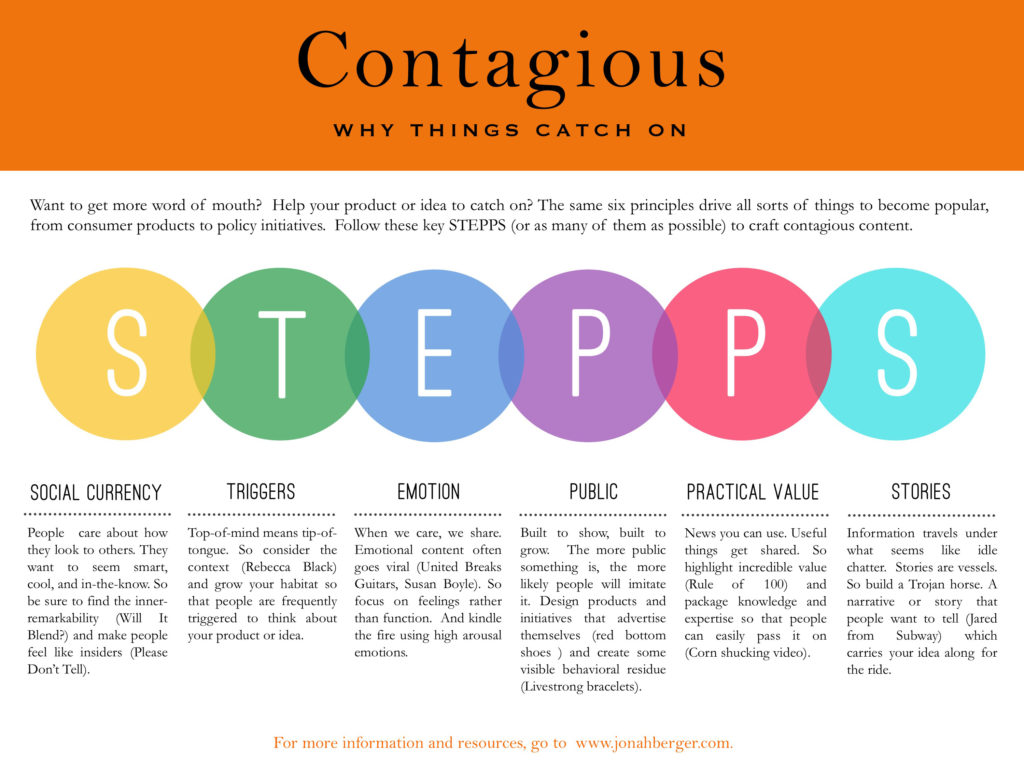Two weeks ago, I wrote a blog describing the reason why your social media is failing (if you do not read it, you can find it HERE). To increase engagement, we need to tap into the true motivations and passions of your target audience. GREAT! So you have listed out the true passions of your target audience and what truly motivates them, but how do you turn this into actual content?
Lucky for us, Wharton School of Business professor Jonah Berger compiled years of content research into a simple framework for you to follow, it is called STEPPS. Each letter in the acronym stands for a different style of content proven to increase engagement. They are Social Currency, Triggers, Emotions, Public, Practical, and Stories. Below is an easy to follow image from JonahBerger.com that outlines STEPPS:
Social Currency
People share what makes them look good. People will often share content that is in line with their ideal self-image to achieve a desired impression or reputation from others. For example, if someone wants to be known as adventurous, they may share content of adventurous hiking trails, mountain ranges, or extreme obstacle races. If someone wants to be perceived as luxurious or prestigious, they may share content of exclusive cars, high fashion, or exotic vacations. There are four ways to achieve social currency:
- Tool of Self Expression
- What is the ideal self-image your target seeks to portray? What type of content can you share that is in line with this ideal self-image?
- Remarkable
- What is the desired self-image your target audience is trying to portray? What remarkable content can you share that is in line with this desired image?
- What content can you share that is extraordinary, unusual, truly remarkable, or just simply interesting in the eyes of your target market?
- Make people feel like insiders
- What valuable insider information can you provide your target audience that few people have access to?
- How can you make your target audience feel like they belong to an exclusive group they would desire to be apart of?
- Game Mechanics
- How can you create a competition to engage your target audience (ex: fantasy football, awards for images with the most likes, ect).
- How can you highlight the accomplishments of your target?
Triggers
People share what is top of mind. It is human nature for our brain to make various associations. For example, when we think of the sky, we think of the color blue. When we think peanut butter, we think jelly. When we think of the candy Skittles, we think of a rainbow. There are two ways to create a trigger association:
- Play on pop culture or current events.
- What is popular in the news right now that our target is actively talking about? How can you associate your brand with this?
- What season or holidays are coming up? How can you associate your brand with this?
- What activities do your target audience engage in on a regular basis? How can you position your brand around these activities (Ex Kit Kat campaign with a break at work)?
- Top of Mind
- What is your target consistently thinking of, or what activities are they engaged in on a consistent basis? How can your brand playoff this?
- For example, Kit Kat targeted working professionals. Working professionals always have a coffee break, which is a reoccurring activity, thus top of mind. Kit Kat created a trigger campaign so when people think coffee break, they think of Kit Kat’s slogan “Give me a Break”.
- Create an association.
- When people think of your brand, what do you want them to think of? (EX: Nike – Just Do It, M&M’s – Melts in your mouth not your hands.)
- How can you use the 5 senses to create a trigger (EX: aroma of a cafe, the music of a high fashion retailer, or the extravagant scenery of Disney World)
- In order to develop a true name association, the following must occur:
- The trigger must be believable in the mind of your consumer. Ex: McDonald’s is not going to create a brand association that they are the healthy choice.
- The Trigger must be CLEARLY front and center in the campaign.
- Heavy consistency and branding is needed for the trigger to be remembered.
Emotions
When we care we share. Emotional content is more likely to be shared (Heath et al., 2001), thus content that focuses on the feelings and emotions of your target audience can be very effective. When you are creating content, put yourself in the shoes of your target audience. What emotions are they feeling, what are they passionate about? How can you create content that revolves around these emotions?
Emotions can be positive or negative, as long as it is a highly active emotion your target is passionate about. Examples of some emotions can include:
- Nostalgia
- Inspiration
- Compassion
- Love
- Justice/Injustice
- Frustration
- Humor
Public
People will share what they see others doing. People will often imitate the actions of others, in others words, they will do what everyone else is doing. This can include buying a product because it’s the new fad, to even sharing a selfie under a trending hashtag because all of their friends are doing it. This is called social proof. In this style, the goal is to create content that displays people engaging with your brand or product in public. This can include:
- Public engagements with your brand
- What type of content can you create that displays your target audience engaging with your brand?
- What entities are influential to your target audience? How can you engage these entities with your brand, and create content around this engagement?
- User-Generated Content (UGC)
- In the previous example, the marketer publishes the content, however, in this section you are encouraging your clientele to publish the content. How can you encourage your target to post their own content on social media of them engaging with your brand? Examples of this are:
- ALS Ice Bucket Challenge
- Disney encouraging fans to post pictures of them with their Mickey Ears on social media
- A car dealer asking customers to post pictures of them with thier new car on social media
- Share a Coke campaign
- Pepsi Like Machine
- In the previous example, the marketer publishes the content, however, in this section you are encouraging your clientele to publish the content. How can you encourage your target to post their own content on social media of them engaging with your brand? Examples of this are:
- Testimonials
- How can you create content focusing on testimonials of satisfied consumers?
- Hashtags
- Hashtags allow social media users to view all public mentions associated with that hashtag.
Practical
People will engage with useful information that is simple and practical. What type of practical information can you provide for your target audience that will help them accomplish what they desire to achieve or overcome a problem they are facing? Examples of this are:
- How to guides
- Cheat sheets
- Webinars
- Instructional videos
- Podcasts
- Coupons
Stories
It is human nature to process information through narratives, not a list of facts. When brands tell stories, it humanizes a brand and makes it relatable. What is your brand’s story? What stories can you tell of the people behind your brand? hat personal stories of triumph can you tell of people engaging with your brand?






